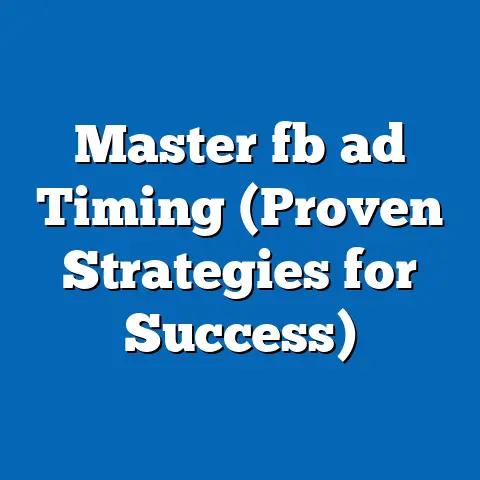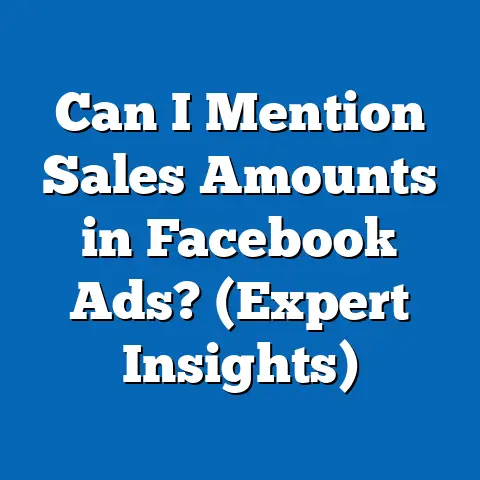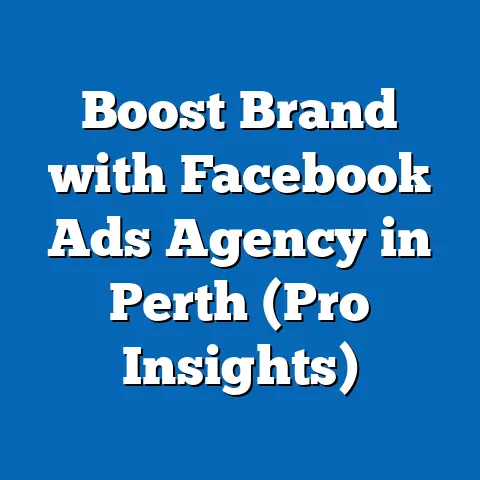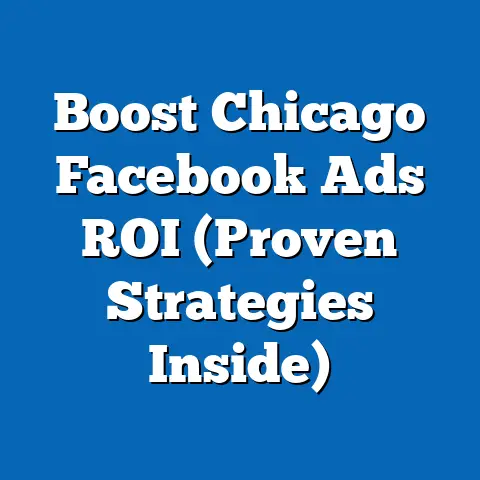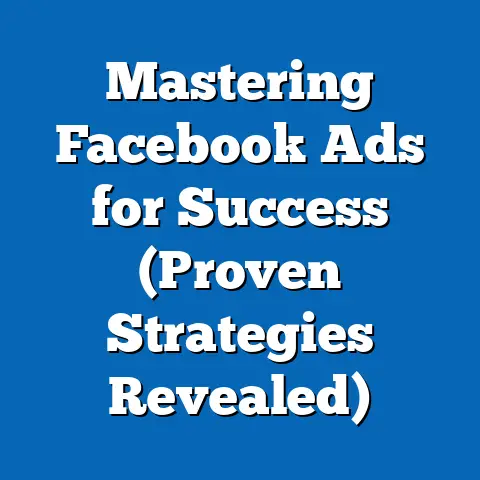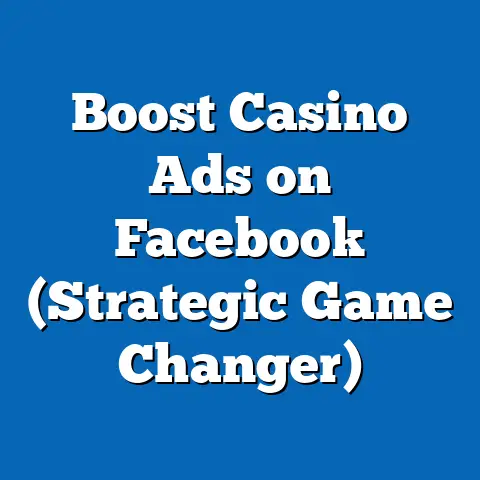Master Facebook Ads: Solve Ad Creation Issues (Expert Insights)
Did you know that over 90 million small businesses actively use Facebook for marketing? As a digital marketing specialist, I’ve witnessed firsthand the incredible power of Facebook ads to connect businesses with their ideal customers. However, this vast potential often comes with a steep learning curve. Many businesses, both large and small, struggle with common ad creation issues that can hinder their success and waste valuable ad spend. I’ve seen countless campaigns falter due to creative fatigue, ad rejections, ineffective targeting, and poor engagement rates.
1. Understanding the Facebook Ads Ecosystem
Before we tackle the common issues, it’s crucial to have a solid understanding of the foundation. Think of it like building a house; you need a strong foundation before you can start adding walls and a roof.
1.1 Overview of Facebook Advertising
Facebook advertising has evolved dramatically since its inception. I remember when it was just simple text ads and basic targeting. Now, it’s a sophisticated platform with a wide array of ad formats and targeting options.
- The Evolution: Facebook ads have gone from simple sidebar ads to highly engaging, visually rich experiences. This evolution reflects the changing user behavior and the increasing sophistication of marketing strategies.
- Significance: Facebook’s massive user base (over 2.9 billion monthly active users) makes it an unparalleled platform for reaching a diverse range of audiences. Its advanced targeting capabilities allow you to pinpoint your ideal customers with remarkable precision.
-
Ad Formats: Facebook offers a variety of ad formats to suit different marketing objectives:
- Image Ads: Simple and effective for showcasing products or services.
- Video Ads: Highly engaging and ideal for storytelling and demonstrations.
- Carousel Ads: Allow you to display multiple images or videos in a single ad, perfect for showcasing a range of products.
- Collection Ads: Designed for mobile shopping, allowing users to browse and purchase products directly from the ad.
- Instant Experience Ads: Full-screen, mobile-optimized ads that load instantly, providing an immersive experience.
- Lead Ads: Capture leads directly within Facebook, making it easy for users to sign up for newsletters or request more information.
- Offer Ads: Promote special deals and discounts, encouraging users to make a purchase.
I’ve personally found that experimenting with different ad formats is key to finding what resonates best with your specific audience. For example, a local bakery I worked with saw a significant increase in engagement when they switched from static image ads to short video ads showcasing their daily specials.
Ad Formats: Facebook offers a variety of ad formats to suit different marketing objectives:
- Image Ads: Simple and effective for showcasing products or services.
- Video Ads: Highly engaging and ideal for storytelling and demonstrations.
- Carousel Ads: Allow you to display multiple images or videos in a single ad, perfect for showcasing a range of products.
- Collection Ads: Designed for mobile shopping, allowing users to browse and purchase products directly from the ad.
- Instant Experience Ads: Full-screen, mobile-optimized ads that load instantly, providing an immersive experience.
- Lead Ads: Capture leads directly within Facebook, making it easy for users to sign up for newsletters or request more information.
- Offer Ads: Promote special deals and discounts, encouraging users to make a purchase.
I’ve personally found that experimenting with different ad formats is key to finding what resonates best with your specific audience. For example, a local bakery I worked with saw a significant increase in engagement when they switched from static image ads to short video ads showcasing their daily specials.
1.2 Target Audience Insights
Defining your target audience is perhaps the most critical step in creating successful Facebook ads. It’s like aiming a bow and arrow; if you don’t know where the target is, you’re just shooting arrows into the dark.
- Importance: Understanding your target audience allows you to create ads that are relevant and engaging, increasing the likelihood of conversions.
-
Tools: Facebook provides several powerful tools for gaining audience insights:
- Facebook Audience Insights: This tool provides detailed information about your audience’s demographics, interests, behaviors, and more. It’s a goldmine of data for understanding who your ideal customers are.
- Facebook Pixel: A small piece of code that you place on your website to track user behavior. This data can be used to create custom audiences and retarget users who have interacted with your website.
- Customer Lists: You can upload your existing customer lists to Facebook to create custom audiences. This allows you to target your existing customers with specific ads or create lookalike audiences based on their characteristics.
I once worked with an e-commerce store that was struggling to generate sales. By using Facebook Audience Insights, we discovered that their target audience was much younger and more interested in sustainable products than they had initially thought. We revamped their ad creatives and targeting to align with these insights, resulting in a 30% increase in sales within a month.
Tools: Facebook provides several powerful tools for gaining audience insights:
- Facebook Audience Insights: This tool provides detailed information about your audience’s demographics, interests, behaviors, and more. It’s a goldmine of data for understanding who your ideal customers are.
- Facebook Pixel: A small piece of code that you place on your website to track user behavior. This data can be used to create custom audiences and retarget users who have interacted with your website.
- Customer Lists: You can upload your existing customer lists to Facebook to create custom audiences. This allows you to target your existing customers with specific ads or create lookalike audiences based on their characteristics.
I once worked with an e-commerce store that was struggling to generate sales. By using Facebook Audience Insights, we discovered that their target audience was much younger and more interested in sustainable products than they had initially thought. We revamped their ad creatives and targeting to align with these insights, resulting in a 30% increase in sales within a month.
1.3 Setting Objectives
Before you create your ads, you need to define your campaign objectives. What do you want to achieve with your Facebook ads? Are you looking to increase brand awareness, drive traffic to your website, or generate leads?
-
Campaign Objectives: Facebook offers a range of campaign objectives to choose from:
- Awareness: Increase brand awareness and reach a broad audience.
- Consideration: Drive traffic to your website, generate engagement, or get video views.
- Conversion: Generate leads, drive sales, or encourage app installs.
-
Influence on Ad Creation: Your campaign objective should guide your ad creation process. For example, if your objective is to increase brand awareness, you’ll want to focus on creating visually appealing ads that capture attention and communicate your brand message. If your objective is to generate leads, you’ll want to create ads that include a clear call to action and a lead capture form.
I always advise my clients to start with a clear understanding of their business goals and then choose the campaign objective that best aligns with those goals. This ensures that their Facebook ads are working towards a specific, measurable outcome.
Campaign Objectives: Facebook offers a range of campaign objectives to choose from:
- Awareness: Increase brand awareness and reach a broad audience.
- Consideration: Drive traffic to your website, generate engagement, or get video views.
- Conversion: Generate leads, drive sales, or encourage app installs.
Influence on Ad Creation: Your campaign objective should guide your ad creation process. For example, if your objective is to increase brand awareness, you’ll want to focus on creating visually appealing ads that capture attention and communicate your brand message. If your objective is to generate leads, you’ll want to create ads that include a clear call to action and a lead capture form.
I always advise my clients to start with a clear understanding of their business goals and then choose the campaign objective that best aligns with those goals. This ensures that their Facebook ads are working towards a specific, measurable outcome.
Key Takeaway: Understanding the Facebook ads ecosystem, including the various ad formats, targeting options, and campaign objectives, is essential for creating successful ads. Take the time to explore these elements and tailor your approach to your specific business goals and target audience.
2. Common Ad Creation Issues
Now that we’ve covered the basics, let’s delve into the common issues that plague many Facebook advertisers. These are the hurdles that can trip you up and prevent you from achieving your desired results.
2.1 Creative Fatigue
Creative fatigue is a common problem that occurs when your audience becomes tired of seeing the same ads over and over again. It’s like listening to the same song on repeat; eventually, you’ll get sick of it.
- Definition: Creative fatigue is the decline in ad performance due to audience saturation.
- Impact: It leads to decreased engagement, lower click-through rates, and ultimately, a decline in conversions.
-
Signs: Keep an eye out for these warning signs:
- Decreasing click-through rates (CTR)
- Lower engagement rates (likes, comments, shares)
- Increasing cost per click (CPC)
- Decreasing return on ad spend (ROAS)
I remember running a campaign for a clothing brand that was initially very successful. However, after a few weeks, we noticed a significant drop in engagement and sales. We realized that our audience was experiencing creative fatigue and that we needed to refresh our ad creatives.
Signs: Keep an eye out for these warning signs:
- Decreasing click-through rates (CTR)
- Lower engagement rates (likes, comments, shares)
- Increasing cost per click (CPC)
- Decreasing return on ad spend (ROAS)
I remember running a campaign for a clothing brand that was initially very successful. However, after a few weeks, we noticed a significant drop in engagement and sales. We realized that our audience was experiencing creative fatigue and that we needed to refresh our ad creatives.
2.2 Ad Rejection
Ad rejection is a frustrating experience that can happen to anyone. Facebook has strict advertising policies, and if your ads violate these policies, they will be rejected.
-
Common Reasons: Here are some common reasons for ad disapproval:
- Misleading Content: Ads that make false or exaggerated claims.
- Violations of Community Standards: Ads that promote violence, hate speech, or discrimination.
- Copyright Infringement: Ads that use copyrighted material without permission.
- Prohibited Content: Ads that promote illegal products or services.
- Poor Grammar and Spelling: Ads that are poorly written and difficult to understand.
- Sensational Content: Ads that use clickbait or sensational headlines.
I once had an ad rejected because it used a before-and-after image that was deemed “unrealistic” by Facebook’s algorithm. It was a legitimate transformation, but the algorithm flagged it as potentially misleading.
-
Examples: Here are some examples of violations:
- An ad claiming to “cure” a disease.
- An ad promoting the sale of illegal drugs.
- An ad using copyrighted music without permission.
- An ad targeting users based on their race or religion.
Common Reasons: Here are some common reasons for ad disapproval:
- Misleading Content: Ads that make false or exaggerated claims.
- Violations of Community Standards: Ads that promote violence, hate speech, or discrimination.
- Copyright Infringement: Ads that use copyrighted material without permission.
- Prohibited Content: Ads that promote illegal products or services.
- Poor Grammar and Spelling: Ads that are poorly written and difficult to understand.
- Sensational Content: Ads that use clickbait or sensational headlines.
I once had an ad rejected because it used a before-and-after image that was deemed “unrealistic” by Facebook’s algorithm. It was a legitimate transformation, but the algorithm flagged it as potentially misleading.
Examples: Here are some examples of violations:
- An ad claiming to “cure” a disease.
- An ad promoting the sale of illegal drugs.
- An ad using copyrighted music without permission.
- An ad targeting users based on their race or religion.
2.3 Ineffective Targeting
Ineffective targeting is another common pitfall that can lead to wasted ad spend and poor results. If you’re not targeting the right audience, your ads will fall on deaf ears.
-
Pitfalls: Here are some common targeting mistakes:
- Broad Targeting: Targeting too broad of an audience, resulting in low relevance and wasted ad spend.
- Incorrect Interests: Targeting users based on irrelevant interests, leading to low engagement.
- Ignoring Demographics: Failing to consider demographic factors such as age, gender, and location.
- Not Using Custom Audiences: Neglecting to use custom audiences and lookalike audiences to target your most valuable prospects.
I’ve seen many businesses make the mistake of targeting everyone in a specific geographic area. While this may seem like a good way to reach a large audience, it often results in low relevance and wasted ad spend.
-
Avoiding Mistakes: To avoid these mistakes, take the time to research your target audience and use Facebook’s advanced targeting options to pinpoint your ideal customers.
Pitfalls: Here are some common targeting mistakes:
- Broad Targeting: Targeting too broad of an audience, resulting in low relevance and wasted ad spend.
- Incorrect Interests: Targeting users based on irrelevant interests, leading to low engagement.
- Ignoring Demographics: Failing to consider demographic factors such as age, gender, and location.
- Not Using Custom Audiences: Neglecting to use custom audiences and lookalike audiences to target your most valuable prospects.
I’ve seen many businesses make the mistake of targeting everyone in a specific geographic area. While this may seem like a good way to reach a large audience, it often results in low relevance and wasted ad spend.
Avoiding Mistakes: To avoid these mistakes, take the time to research your target audience and use Facebook’s advanced targeting options to pinpoint your ideal customers.
2.4 Poor Engagement Rates
Poor engagement rates are a sign that your ads are not resonating with your audience. If your ads are not generating likes, comments, shares, and clicks, it’s time to re-evaluate your approach.
-
Factors: Several factors can contribute to low engagement rates:
- Uncompelling Visuals: Ads with low-quality or irrelevant visuals are likely to be ignored.
- Weak Copy: Ads with weak or unpersuasive copy will fail to capture attention and drive action.
- Irrelevant Offer: Ads that promote an irrelevant offer will not resonate with the target audience.
- Poor Placement: Ads that are placed in the wrong location may not be seen by the right people.
I often see ads that are visually unappealing or have poorly written copy. These ads are almost guaranteed to have low engagement rates.
-
Importance of Visuals and Copy: Compelling visuals and persuasive copy are essential for capturing attention and driving engagement. Your visuals should be high-quality, relevant, and eye-catching. Your copy should be clear, concise, and persuasive, highlighting the benefits of your offer.
Factors: Several factors can contribute to low engagement rates:
- Uncompelling Visuals: Ads with low-quality or irrelevant visuals are likely to be ignored.
- Weak Copy: Ads with weak or unpersuasive copy will fail to capture attention and drive action.
- Irrelevant Offer: Ads that promote an irrelevant offer will not resonate with the target audience.
- Poor Placement: Ads that are placed in the wrong location may not be seen by the right people.
I often see ads that are visually unappealing or have poorly written copy. These ads are almost guaranteed to have low engagement rates.
Importance of Visuals and Copy: Compelling visuals and persuasive copy are essential for capturing attention and driving engagement. Your visuals should be high-quality, relevant, and eye-catching. Your copy should be clear, concise, and persuasive, highlighting the benefits of your offer.
Key Takeaway: Recognizing and addressing these common ad creation issues is crucial for maximizing the effectiveness of your Facebook advertising campaigns. By understanding the signs of creative fatigue, avoiding ad rejections, targeting the right audience, and creating compelling ads, you can significantly improve your results.
3. Expert Insights & Solutions
Now, let’s move on to the solutions. This is where I’ll share expert insights and actionable strategies to help you overcome the common ad creation issues we’ve discussed.
3.1 Strategies for Overcoming Creative Fatigue
Overcoming creative fatigue requires a proactive and strategic approach. It’s not enough to simply create new ads; you need to understand why your ads are losing their effectiveness and address the underlying issues.
-
Refreshing Ad Creatives: Here are some expert tips for refreshing your ad creatives:
- Experiment with Different Visuals: Try using different images, videos, and ad formats to see what resonates best with your audience.
- Update Your Copy: Refresh your ad copy with new headlines, descriptions, and calls to action.
- Target Different Audiences: Try targeting different audience segments to see if you can find new pockets of engagement.
- Rotate Your Ads: Regularly rotate your ads to prevent your audience from seeing the same ads over and over again.
-
Case Studies: Here are some case studies of successful ad campaigns that revitalized their approach:
- Dollar Shave Club: Dollar Shave Club is known for its humorous and engaging video ads. When their initial ads started to lose their effectiveness, they created a new series of ads that were even more outrageous and entertaining, resulting in a significant boost in engagement and sales.
- Old Spice: Old Spice revitalized their brand with a series of memorable and humorous ads featuring Isaiah Mustafa. These ads went viral and helped Old Spice reach a new generation of customers.
I worked with a local restaurant that was experiencing creative fatigue. We decided to create a series of short video ads showcasing their different menu items. We also ran a contest where users could submit their own recipes for a chance to be featured on the menu. This resulted in a significant increase in engagement and traffic to their restaurant.
Refreshing Ad Creatives: Here are some expert tips for refreshing your ad creatives:
- Experiment with Different Visuals: Try using different images, videos, and ad formats to see what resonates best with your audience.
- Update Your Copy: Refresh your ad copy with new headlines, descriptions, and calls to action.
- Target Different Audiences: Try targeting different audience segments to see if you can find new pockets of engagement.
- Rotate Your Ads: Regularly rotate your ads to prevent your audience from seeing the same ads over and over again.
Case Studies: Here are some case studies of successful ad campaigns that revitalized their approach:
- Dollar Shave Club: Dollar Shave Club is known for its humorous and engaging video ads. When their initial ads started to lose their effectiveness, they created a new series of ads that were even more outrageous and entertaining, resulting in a significant boost in engagement and sales.
- Old Spice: Old Spice revitalized their brand with a series of memorable and humorous ads featuring Isaiah Mustafa. These ads went viral and helped Old Spice reach a new generation of customers.
I worked with a local restaurant that was experiencing creative fatigue. We decided to create a series of short video ads showcasing their different menu items. We also ran a contest where users could submit their own recipes for a chance to be featured on the menu. This resulted in a significant increase in engagement and traffic to their restaurant.
3.2 Navigating Ad Rejections
Navigating ad rejections can be tricky, but with a clear understanding of Facebook’s advertising policies, you can minimize the risk of having your ads disapproved.
-
Expert Tips: Here are some expert tips on how to align your ad content with Facebook’s advertising policies:
- Review Facebook’s Advertising Policies: Familiarize yourself with Facebook’s advertising policies and guidelines.
- Avoid Misleading Claims: Make sure your ads are accurate and do not make false or exaggerated claims.
- Respect Community Standards: Ensure that your ads do not promote violence, hate speech, or discrimination.
- Obtain Necessary Permissions: If you’re using copyrighted material, obtain the necessary permissions.
- Proofread Your Ads: Proofread your ads carefully to ensure that they are free of grammatical errors and spelling mistakes.
-
Checklist: Here’s a checklist to ensure compliance before submission:
- [ ] Does your ad comply with Facebook’s advertising policies?
- [ ] Is your ad accurate and truthful?
- [ ] Does your ad respect community standards?
- [ ] Have you obtained the necessary permissions for any copyrighted material?
- [ ] Is your ad free of grammatical errors and spelling mistakes?
I always recommend that my clients review Facebook’s advertising policies before creating any ads. This helps them avoid common pitfalls and ensures that their ads are more likely to be approved.
Expert Tips: Here are some expert tips on how to align your ad content with Facebook’s advertising policies:
- Review Facebook’s Advertising Policies: Familiarize yourself with Facebook’s advertising policies and guidelines.
- Avoid Misleading Claims: Make sure your ads are accurate and do not make false or exaggerated claims.
- Respect Community Standards: Ensure that your ads do not promote violence, hate speech, or discrimination.
- Obtain Necessary Permissions: If you’re using copyrighted material, obtain the necessary permissions.
- Proofread Your Ads: Proofread your ads carefully to ensure that they are free of grammatical errors and spelling mistakes.
Checklist: Here’s a checklist to ensure compliance before submission:
- [ ] Does your ad comply with Facebook’s advertising policies?
- [ ] Is your ad accurate and truthful?
- [ ] Does your ad respect community standards?
- [ ] Have you obtained the necessary permissions for any copyrighted material?
- [ ] Is your ad free of grammatical errors and spelling mistakes?
I always recommend that my clients review Facebook’s advertising policies before creating any ads. This helps them avoid common pitfalls and ensures that their ads are more likely to be approved.
3.3 Mastering Audience Targeting
Mastering audience targeting is essential for reaching the right people with your ads and maximizing your return on ad spend.
-
Advanced Techniques: Here are some advanced techniques for refining your audience segments:
- Layered Targeting: Use layered targeting to combine different demographic, interest, and behavioral factors.
- Custom Audiences: Create custom audiences based on your website traffic, customer lists, and app activity.
- Lookalike Audiences: Create lookalike audiences based on your custom audiences to reach new prospects who are similar to your best customers.
- Retargeting: Retarget users who have interacted with your website or app with specific ads.
-
Lookalike Audiences and Retargeting:
- Lookalike Audiences: Lookalike audiences are a powerful way to reach new prospects who are similar to your existing customers. Facebook uses its vast database to identify users who share similar characteristics, interests, and behaviors with your custom audiences.
- Retargeting: Retargeting allows you to target users who have previously interacted with your website or app. This is a highly effective strategy for driving conversions, as these users are already familiar with your brand and products.
I’ve seen incredible results with lookalike audiences and retargeting. By targeting users who are similar to my best customers, I’ve been able to significantly increase my conversion rates and return on ad spend.
Advanced Techniques: Here are some advanced techniques for refining your audience segments:
- Layered Targeting: Use layered targeting to combine different demographic, interest, and behavioral factors.
- Custom Audiences: Create custom audiences based on your website traffic, customer lists, and app activity.
- Lookalike Audiences: Create lookalike audiences based on your custom audiences to reach new prospects who are similar to your best customers.
- Retargeting: Retarget users who have interacted with your website or app with specific ads.
Lookalike Audiences and Retargeting:
- Lookalike Audiences: Lookalike audiences are a powerful way to reach new prospects who are similar to your existing customers. Facebook uses its vast database to identify users who share similar characteristics, interests, and behaviors with your custom audiences.
- Retargeting: Retargeting allows you to target users who have previously interacted with your website or app. This is a highly effective strategy for driving conversions, as these users are already familiar with your brand and products.
I’ve seen incredible results with lookalike audiences and retargeting. By targeting users who are similar to my best customers, I’ve been able to significantly increase my conversion rates and return on ad spend.
3.4 Boosting Engagement Rates
Boosting engagement rates requires a deep understanding of your target audience and a willingness to experiment with different ad formats, visuals, and copy.
-
High-Converting Ad Copy and Visuals: Here are some expert recommendations for crafting high-converting ad copy and visuals:
- Use High-Quality Visuals: Use high-quality images and videos that are visually appealing and relevant to your offer.
- Write Compelling Headlines: Write headlines that grab attention and pique curiosity.
- Highlight the Benefits: Focus on the benefits of your offer, rather than just the features.
- Include a Clear Call to Action: Tell users what you want them to do, such as “Shop Now,” “Learn More,” or “Sign Up.”
- Use Social Proof: Include testimonials, reviews, and other forms of social proof to build trust and credibility.
-
A/B Testing: A/B testing is a crucial part of optimizing engagement. It allows you to test different versions of your ads to see which ones perform best.
- Test Different Elements: Test different headlines, descriptions, visuals, calls to action, and targeting options.
- Track Your Results: Track your results carefully to see which variations are generating the most engagement and conversions.
- Iterate and Improve: Use your findings to iterate and improve your ads over time.
I always tell my clients that A/B testing is not a one-time thing. It’s an ongoing process of experimentation and optimization. The more you test, the more you’ll learn about what resonates with your audience and the better your ads will perform.
High-Converting Ad Copy and Visuals: Here are some expert recommendations for crafting high-converting ad copy and visuals:
- Use High-Quality Visuals: Use high-quality images and videos that are visually appealing and relevant to your offer.
- Write Compelling Headlines: Write headlines that grab attention and pique curiosity.
- Highlight the Benefits: Focus on the benefits of your offer, rather than just the features.
- Include a Clear Call to Action: Tell users what you want them to do, such as “Shop Now,” “Learn More,” or “Sign Up.”
- Use Social Proof: Include testimonials, reviews, and other forms of social proof to build trust and credibility.
A/B Testing: A/B testing is a crucial part of optimizing engagement. It allows you to test different versions of your ads to see which ones perform best.
- Test Different Elements: Test different headlines, descriptions, visuals, calls to action, and targeting options.
- Track Your Results: Track your results carefully to see which variations are generating the most engagement and conversions.
- Iterate and Improve: Use your findings to iterate and improve your ads over time.
I always tell my clients that A/B testing is not a one-time thing. It’s an ongoing process of experimentation and optimization. The more you test, the more you’ll learn about what resonates with your audience and the better your ads will perform.
Key Takeaway: By implementing these expert insights and solutions, you can overcome common ad creation issues and significantly improve the performance of your Facebook advertising campaigns. Remember to stay proactive, experiment with different approaches, and continuously optimize your ads based on your results.
4. The Future of Facebook Advertising
The world of Facebook advertising is constantly evolving, and it’s important to stay ahead of the curve to maintain a competitive edge. Let’s take a look at some of the trends that are shaping the future of Facebook advertising.
4.1 Trends Influencing Facebook Ads
Several emerging trends are poised to significantly impact the future of Facebook advertising.
- Augmented Reality Ads: Augmented reality (AR) ads allow users to interact with your products in a virtual environment. This can be a powerful way to engage customers and drive sales.
- AI-Driven Targeting: Artificial intelligence (AI) is being used to improve targeting and personalization. AI algorithms can analyze vast amounts of data to identify the most relevant prospects for your ads.
-
Personalized Marketing: Personalized marketing involves tailoring your ads to the individual needs and preferences of each user. This can be achieved through dynamic content, personalized offers, and targeted messaging.
I believe that AR ads and AI-driven targeting will be particularly impactful in the coming years. AR ads offer a unique and engaging way to showcase products, while AI-driven targeting will help advertisers reach the right people with the right message at the right time.
Personalized Marketing: Personalized marketing involves tailoring your ads to the individual needs and preferences of each user. This can be achieved through dynamic content, personalized offers, and targeted messaging.
I believe that AR ads and AI-driven targeting will be particularly impactful in the coming years. AR ads offer a unique and engaging way to showcase products, while AI-driven targeting will help advertisers reach the right people with the right message at the right time.
4.2 Preparing for Changes in Advertising Policies
Facebook’s advertising policies are constantly evolving, and it’s important to stay informed about these changes to avoid having your ads rejected.
-
Staying Ahead: Here are some tips for staying ahead of policy changes:
- Follow Facebook’s Official Blog: Subscribe to Facebook’s official blog to stay up-to-date on the latest news and updates.
- Join Industry Forums: Participate in industry forums and online communities to share information and insights with other advertisers.
- Attend Webinars and Conferences: Attend webinars and conferences to learn from industry experts.
-
Adapting Strategies: Here’s how to adapt your strategies accordingly:
- Review Your Ads Regularly: Review your ads regularly to ensure that they comply with the latest policies.
- Update Your Content: Update your content as needed to reflect any changes in Facebook’s policies.
- Be Proactive: Be proactive in addressing any potential issues before they arise.
I always advise my clients to stay informed about Facebook’s advertising policies and to review their ads regularly to ensure compliance. This helps them avoid costly mistakes and maintain a positive relationship with Facebook.
Staying Ahead: Here are some tips for staying ahead of policy changes:
- Follow Facebook’s Official Blog: Subscribe to Facebook’s official blog to stay up-to-date on the latest news and updates.
- Join Industry Forums: Participate in industry forums and online communities to share information and insights with other advertisers.
- Attend Webinars and Conferences: Attend webinars and conferences to learn from industry experts.
Adapting Strategies: Here’s how to adapt your strategies accordingly:
- Review Your Ads Regularly: Review your ads regularly to ensure that they comply with the latest policies.
- Update Your Content: Update your content as needed to reflect any changes in Facebook’s policies.
- Be Proactive: Be proactive in addressing any potential issues before they arise.
I always advise my clients to stay informed about Facebook’s advertising policies and to review their ads regularly to ensure compliance. This helps them avoid costly mistakes and maintain a positive relationship with Facebook.
4.3 Leveraging Data Analytics
Data analytics is essential for understanding the performance of your Facebook ads and making informed decisions about your advertising strategy.
- Importance: Data analytics provides valuable insights into your audience, your ads, and your overall campaign performance.
-
Analyzing Metrics: Here’s how to effectively analyze ad performance metrics:
- Track Key Metrics: Track key metrics such as click-through rate, cost per click, conversion rate, and return on ad spend.
- Identify Trends: Identify trends and patterns in your data to see what’s working and what’s not.
- Use Data to Optimize: Use your data to optimize your ads, targeting, and bidding strategies.
I rely heavily on data analytics to inform my advertising decisions. By tracking key metrics and identifying trends, I can continuously optimize my campaigns and improve my results.
Analyzing Metrics: Here’s how to effectively analyze ad performance metrics:
- Track Key Metrics: Track key metrics such as click-through rate, cost per click, conversion rate, and return on ad spend.
- Identify Trends: Identify trends and patterns in your data to see what’s working and what’s not.
- Use Data to Optimize: Use your data to optimize your ads, targeting, and bidding strategies.
I rely heavily on data analytics to inform my advertising decisions. By tracking key metrics and identifying trends, I can continuously optimize my campaigns and improve my results.
Key Takeaway: The future of Facebook advertising is dynamic and exciting. By staying informed about emerging trends, adapting to policy changes, and leveraging data analytics, you can position yourself for success in the ever-evolving world of social media advertising.
Conclusion
Mastering Facebook ads is an ongoing journey, but by understanding the common ad creation issues and implementing the expert insights I’ve shared in this article, you can significantly improve your advertising efforts. Remember to stay proactive, experiment with different approaches, and continuously optimize your ads based on your results.
I’ve seen firsthand the transformative power of Facebook ads when executed effectively. It’s not just about creating pretty pictures and catchy slogans; it’s about understanding your audience, crafting compelling messages, and leveraging the platform’s advanced targeting capabilities.
So, take the knowledge you’ve gained today and apply it to your own Facebook advertising campaigns. Don’t be afraid to experiment, learn from your mistakes, and continuously strive to improve. With dedication and a strategic approach, you can unlock the full potential of Facebook ads and transform your business.
The potential of Facebook ads to transform your business when executed effectively is immense. It’s a powerful tool that can help you reach your target audience, drive sales, and grow your brand. Are you ready to harness that power and take your business to the next level?

